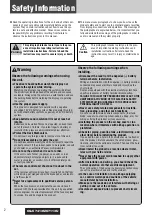
1
1
23
1
1
0
LPF
z
D
2
z
N
N
)
z
(
H
-
-
-
+
=
1
1
23
1
1
0
HPF
z
D
2
z
N
N
)
z
(
H
-
-
-
+
=
DAC
2.4.4 DAC Gain Setting
2.4.4.1
Digital Volume Control
The TLV320DAC3203 signal processing blocks incorporate a digital volume control block that can control
the volume of the playback signal from +24dB to –63.5dB in steps of 0.5dB. These can be controlled by
writing to Page 0, Register 65 and 66. The volume control of left and right channels by default can be
controlled independently, however by programming Page 0, Reg 64, Bits D1-D0), they can be made
interdependent. The volume changes are soft-stepped in steps of 0.5dB to avoid audible artifacts during
gain change. The rate of soft-stepping can be controlled by programming Page 0, Reg 63, Bits D1-D0) to
either one step per frame (DAC_FS ) or one step per 2 frames. The soft-stepping feature can also be
entirely disabled. During soft-stepping the value of the actual applied gain would differ from the
programmed gain in register. The TLV320DAC3203 gives a feedback to the user in form of register
readable flag to indicate that soft-stepping is currently in progress. The flags for left and right channels can
be read back by reading Page 0, Reg 38, Bits D4) and D(0) respectively. A value of 0 in these flags
indicates a soft-stepping operation in progress, and a value of 1 indicates that soft-stepping has
completed. A soft-stepping operation comes into effect during a) power-up, when the volume control soft-
steps from –63.5dB to programmed gain value b) volume change by user when DAC is powered up and c)
power-down, when the volume control block soft-steps to –63.5dB before powering down the channel.
2.4.4.2
Dynamic Range Compression
Typical music signals are characterized by crest factors, the ratio of peak signal power to average signal
power, of 12dB or more. In order to avoid audible distortions due to clipping of peak signals, the gain of
the DAC channel must be adjusted so as not to cause hard clipping of peak signals. As a result, during
nominal periods, the applied gain is low, causing the perception that the signal is not loud enough. To
overcome this problem, the DRC in the TLV320DAC3203 continuously monitors the output of the DAC
Digital Volume control to detect its power level w.r.t. 0dB FS. When the power level is low, it increases the
input signal gain to make it sound louder. At the same time, if a peaking signal is detected, it
autonomously reduces the applied gain to avoid hard clipping. The resulting sound can be more pleasing
to the ear as well as sounding louder during nominal periods.
The DRC functionality in the TLV320DAC3203 is implemented by a combination of Processing Blocks in
the DAC channel as described in
.
The DRC can be disabled by writing into Page 0, Reg 68, Bits D6-D5).
The DRC typically works on the filtered version of the input signal. The input signals have no audio
information at DC and extremely low frequencies; however they can significantly influence the energy
estimation function in DRC. Also most of the information about signal energy is concentrated in the low
frequency region of the input signal.
In order to estimate the energy of the input signal, the signal is first fed to the DRC high-pass filter and
then to the DRC low-pass filter. These filters are implemented as first-order IIR filters given by
(11)
(12)
The coefficients for these filters are 24-bits wide in two’s-complement and are user programmable through
register write as given in
, and coefficient default values are summarized in
.
Table 2-19. DRC HPF and LPF Coefficients
Coefficient
Location
HPF N0
C71 Page 46, Register 52 to 55
HPF N1
C72 Page 46, Register 56 to 59
HPF D1
C73 Page 46, Register 60 to 63
LPF N0
C74 Page 46, Register 64 to 67
LPF N1
C75 Page 46, Register 68 to 71
44
TLV320DAC3203 Application
SLAU434 – May 2012
Copyright © 2012, Texas Instruments Incorporated
















































